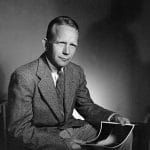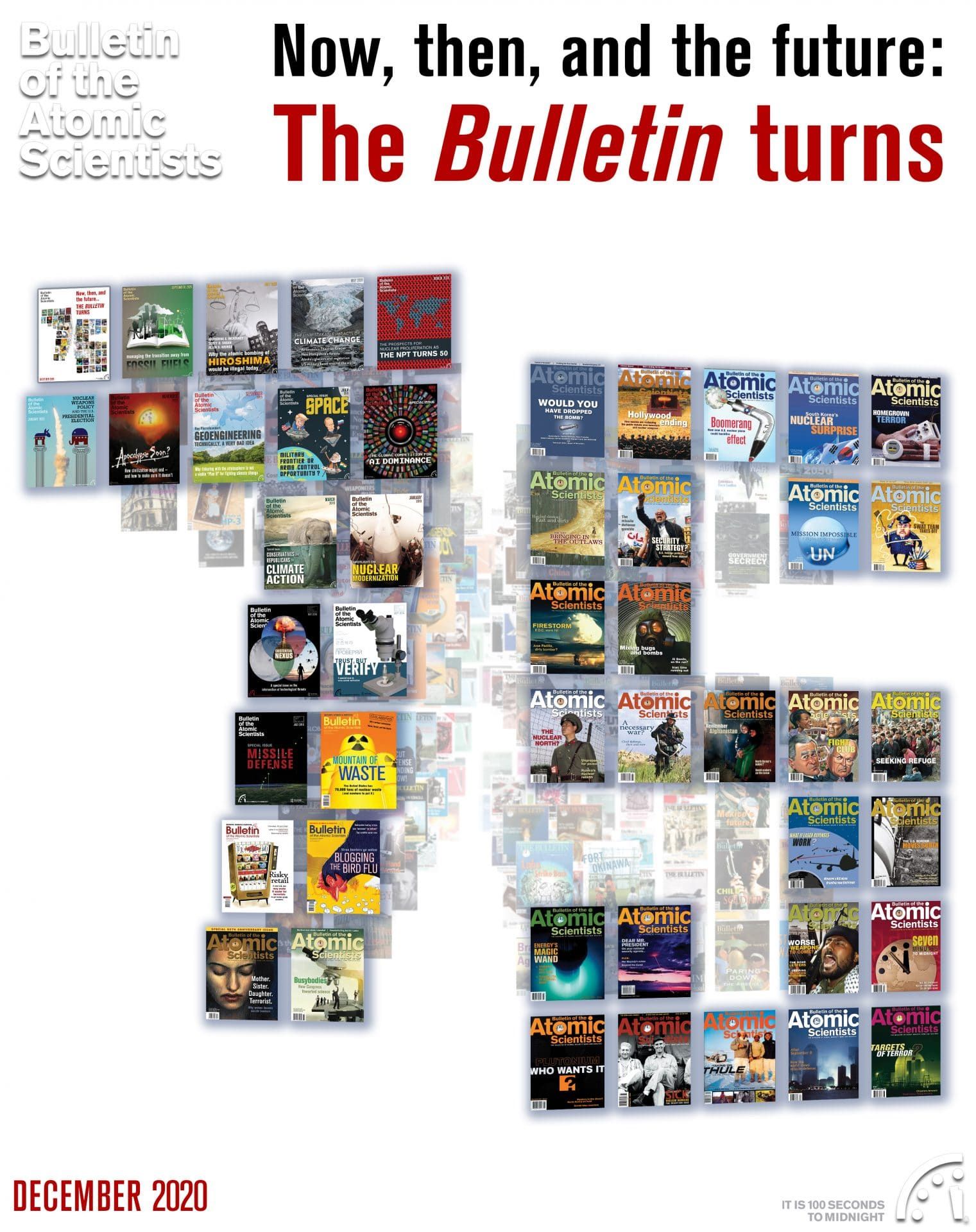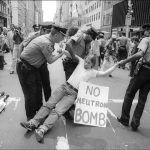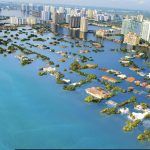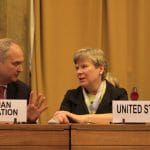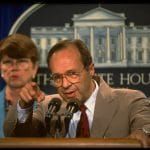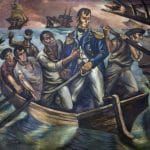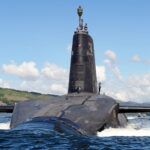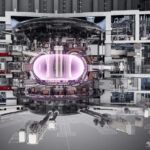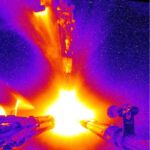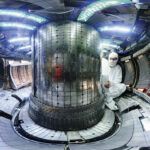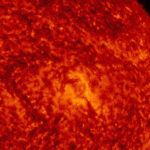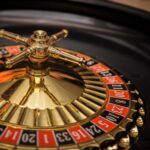1975: All in our time: A foul and awesome display
By Kenneth T. Bainbridge | December 7, 2020
1975: All in our time: A foul and awesome display
By Kenneth T. Bainbridge | December 7, 2020
Editor’s note: This article was originally published in the May 1975 issue of the Bulletin. It is republished here as part of our special issue commemorating the 75th year of the Bulletin.
My first view of the Trinity base camp was in January with David Anderson when we sought a location for an SCR-584 radar to try to follow the ball of fire if the test were successful. A sergeant brought a Weasel by truck from Los Alamos and met us at the north end of the Sierra Oscura. He drove us up through a snow storm. The snow flakes got bigger, the snow got deeper, and with increasing altitude, the trees got closer together and finally blocked our passage. We returned to the valley where I had my car. Anderson and I entered the test area. At that lower elevation the snow had become rain. Slithering on the soapy adobe road we passed through the barracks area and returned to Socorro without being challenged.
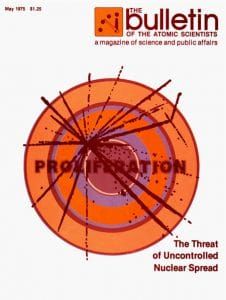 It was Security’s hope that the Trinity site would not be associated with Los Alamos, 230 miles away. But trailer-housed itinerant workers, indigenous to that part of the country, recognized Lt. H. C. Bush and many others at Trinity whom they had known at Los Alamos. When the small group of U.S. Army Engineers did not have the special equipment needed for some construction work, contracts had to be let to civilian firms in order to meet the increasingly tight schedule.
It was Security’s hope that the Trinity site would not be associated with Los Alamos, 230 miles away. But trailer-housed itinerant workers, indigenous to that part of the country, recognized Lt. H. C. Bush and many others at Trinity whom they had known at Los Alamos. When the small group of U.S. Army Engineers did not have the special equipment needed for some construction work, contracts had to be let to civilian firms in order to meet the increasingly tight schedule.
In the autumn of 1944, the plan for a camp completed in December called for housing 160 military and civilian personnel. But on June 1, 1945, in addition to military camp personnel there were 210 scientists and technical aides, 250 by the middle of July, and a total of 425 on the weekend of the test, and a few special guests. We had asked Groves to keep his VIP list below 10 in number.
Instrumentation of test
Victor F. Weisskopf was the chief consultant on plans for instrumentation of the test. He supplied and updated the predictions of the expected yield of the implosion bomb and its radioactive, optical, physical, and nuclear effects—properties essential to planning all of the measurements. Later in 1944 Enrico Fermi joined for nuclear experiments, and in the spring of 1945, William G. Penny advised on blast problems and Joseph 0. Hirschfelder on fallout expectations.
Every new suggestion of a useful measurement was considered on the basis of value, time scale for completion, and available personnel and shop time. Some overlap was allowed for the simpler experiments. The advantage of redundancy was great. No delay of the implosion test on the first practicable date could be supported on the basis, “Our experiment is so important that the test must be delayed until we are ready.”
There were really three classes of experiments scheduled. One set of tests was prepared to obtain 0.034 sec. measurements on blast, optical, and nuclear effects and characteristics. Another set, for which Robert R. Wilson, Bruno Rossi, Kenneth Greisen, Ernest W. Titterton and others were making preparations, was for a more detailed study of the implosion process and a check on the detonators, which would be of great value if the implosion should be imperfect. The measurement on the simultaneity of detonation of the explosive lenses was my least favorite experiment, as it meant that the test bomb was more complicated than the final “production” units, and that the chance of irregular predetonation by pick-up from lightning or any other factor was increased.
A third category was an experiment of great significance for the proposed explosion and for monitoring future atmospheric nuclear explosions anywhere. Herbert L. Anderson had worked it out. He had suggested a radio-chemical method for measuring the yield of a fission weapon. Later it appeared that a great amount of useful information could be obtained from the fall-out of nuclear explosions anywhere in the world. We were able in 1945 to pick up the Hiroshima explosion using specially equipped B-29s in California. Altogether there were some four long-range detection methods of which we tried three in 1945.
It was information on fall-out which was presented to President Truman in September 1949 as proof of the first successful Russian test of a bomb in the atmosphere. This method, available to anyone in the world properly trained in the techniques, was used quite independently by a Japanese physicist to give particularly important scientific results after the first U.S. hydrogen bomb test. I heard in November 1973 that details of the method are still classified by the Atomic Energy Commission.
Anderson proceeded with his idea and secured the aid of Nathan Sugarman’s chemistry group from Chicago, which included D. Engelkemeier, S. Katcoff, J. Miskell and A. Turkevich. A mock-up of 1,000 curies of dissolved reactor fuel was used in the May 7, 1945, rehearsal test at Trinity. Herb Anderson’s experiment did not need and could not be complemented by another experiment. His group was ready and all they needed was a yield of nuclear energy of any amount whatsoever.
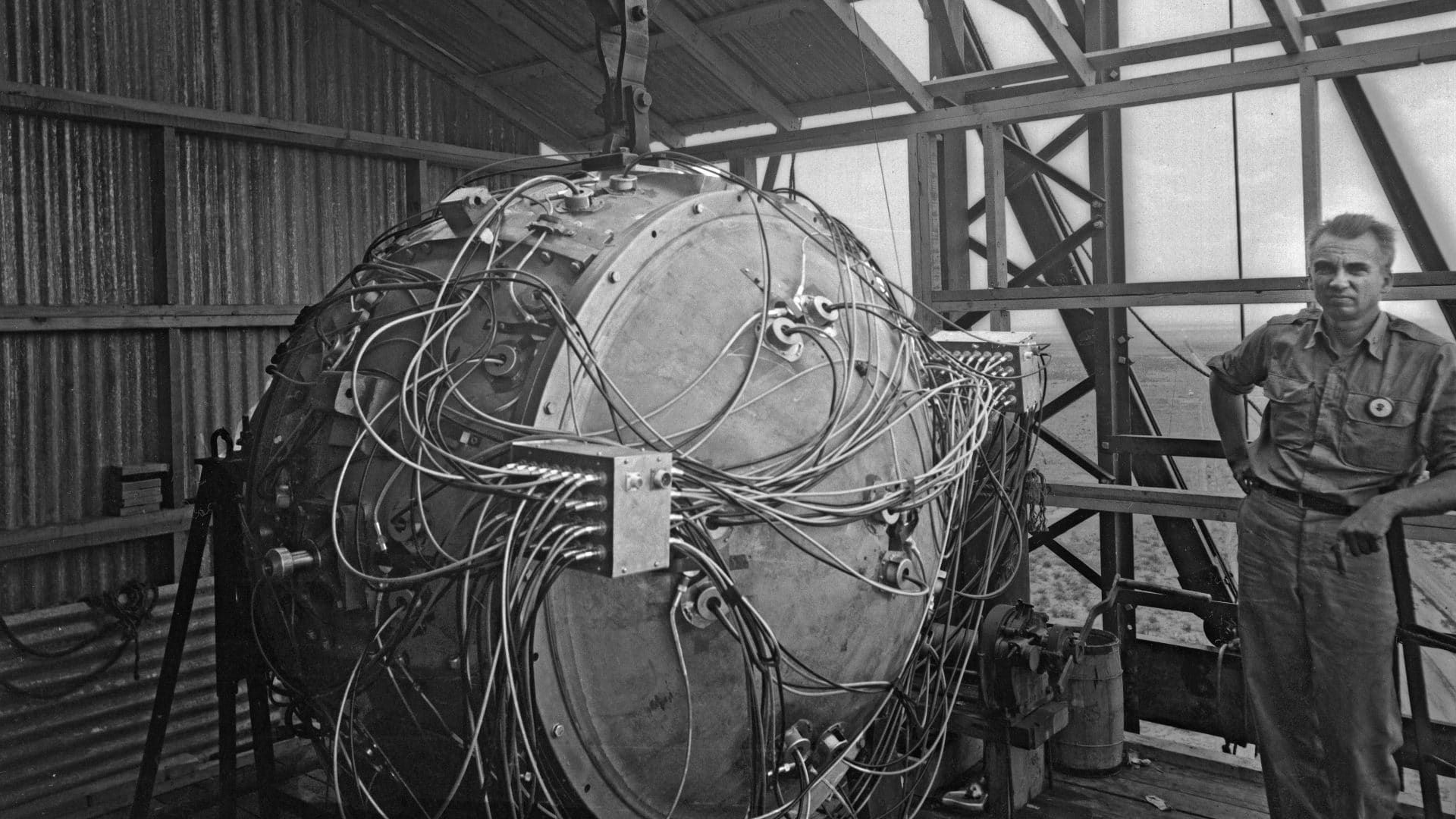
In the summer of 1944, I was convinced that a rehearsal was imperative as there would be only one chance with the main test. A proposal was made to Oppenheimer for a test of 100 tons of explosive, to check our instrumentation and facilities, to calibrate gauges, and to determine weaknesses in the plans and organization. There did not seem to be any properly instrumented prior tests anywhere in this range of 100 tons. Also it was known that explosions above a few tons of TNT would have different blast and scaling characteristics than were well known for smaller explosions. At first opposed to more work and complication, Oppenheimer soon agreed to plans for a rehearsal shot. He later went out of his way to thank me for this insurance to enhance the chances for success of the Trinity explosion.
The 100-ton rehearsal shot planned for May 5 was detonated on May 7. The center of the 100-ton pile was 38 feet above the ground to scale effects to conform to the final implosion test bomb on a 100- foot tower on the basis of the then predicted yield. Kistiakowsky’s division obtained special fast-acting explosives arrayed in the cylindric cubic structure of TNT to improve the speed and uniformity of the explosion. As Kisty told me, these explosives were not sensitive to mechanical shock, which was proven when (a) some boxes fell off a truck transporting the explosives from the rail siding at Pope, and when (b) some boxes fell off the elevator while I was taking a movie record standing on the stairs above the platform while Lt. Bush and his Military Police constructed the array.
The rehearsal accomplished what we had hoped for, or feared. We needed decent roads as the increased traffic for two weeks before the rehearsal had turned the scraped adobe roads to dust which got into everything. One expert-come-lately, eager to add an experiment, drove a car under our low wires and over unburied cables, resulting in last minute breakage and frantic repair to correct the damage. John Williams defined in detail the canine and questionable ancestry of the expert to his face which he took without a whimper. Communication facilities were insufficient or broke down. Other real troubles and some gripes came out in a meeting at Los Alamos.
Groves agreed to putting down 25 miles of blacktop road at $5,000 a mile, enough to provide a waterproof seal over the adobe and caliche. The new roads provided a superlative example of planned obsolescence. Built to last three months, they started to break up 92 days after completion. Hundreds of miles of wire were on low poles off to one side of the road so that checking and repairs could be made rapidly at any location. Every one or two hundred yards two poles were raised and the wires elevated to give safer passage to any car or truck. Cables were buried. The rehearsal shot had gone off 1 /4 second early due to electrical pick-up. This would have been costly in the final test where so many of the results depended on programmed timing down to the last millisecond. This provided one more reason to rule that after four weeks prior to the final test date no new experiments would be added to avoid new wiring with attendant pick-up hazards. Four weeks had been arrived at on the basis of two weeks for installation of new experiments and two weeks to engage in the final tune-up and rehearsals, including a few with B-29 planes from Kirkland Field.
All personnel, except those in the arming party, would be required to clear out of the area within 10,000 yards of Point Zero two hours before the scheduled detonation time. Walk out if a car broke down, but get out!
The night of the successful rehearsal shot was the one and only time at Trinity that I had an alcoholic drink until a few days after the final bomb test. Lieutenant Bush, John Williams and I relaxed at a poker game with John H. Anderson who joined us when he could. Anderson was a civilian security agent I was told. What his job was I never asked and he never volunteered to define. He didn’t act like a psychiatrist. We were feeling good because the explosion had been satisfactory and no one was hurt. In the midst of our celebration, a rocket went off.
There were rockets with wires attached for use as a trial sampling technique to recover plutonium and fission products in a drag cup after the real test, and one of Herb Anderson’s group had picked that night to try one out as he considered it safe to do so now that the 100 tons of explosives were gone. Goodby fun and games! I found Herb Anderson and together we loaded the remaining rockets into a truck and drove to one of our explosives magazines where they were stored and firmly locked up.
In March and in part of April and May, the lower urgency schedule was about as follows: Up at 5 a.m., breakfast; off to work at 6 a.m., an early lunch; office work when the day’s heat around 1 p.m. was too much for physical work outdoors; back to the test area, returning to base at 5 p.m. After supper every day during the week there would be a session on construction led by Williams with Sgt. A. H. Jopp (wiring), Sgt. Gibson (construction), and some group leaders present to report on what had been done and what priority jobs had to be tackled the next day. Sergeant Jopp, a line man for a power company by trade, was the only man who knew where the 500 miles of wire started and stopped. He was side-swiped and knocked down but not injured by a 5-ton Mack truck driven by the only woman working at the site during a flurry of gravel hauling for construction.
After the evening meeting a poker game generally followed, ending at 11 or 12 p.m. The outdoor air and exercise seemed to serve as a substitute for sleep. It was only the last month before the test that contributed to physical and nervous strain to any great degree, largely because there was no time for relaxation.
In the middle of May, on two separate nights in one week, the Air Force mistook the Trinity base for their illuminated target. One bomb fell on the barracks building which housed the carpentry shop, another hit the stables, and a small fire started. Fortunately the barracks occupied by soldiers and civilian scientists were not struck. If the lead plane hit the generator or wires and doused the target lights, then the succeeding planes looked for another illuminated area. This must have been what happened in May of 1945. After all, the crews had come at least a thousand miles to pass their final exam and had probably never been told of anything except targets in the area.
We had requested two SCR-584 gun-director radars and operating crews. This was the radar suggested by Louis Ridenour and developed by Ivan Getting at the MIT Radiation Laboratory which helped to bring down some 90 percent of the V-1 rockets.
Worried about the destruction of all our efforts if some budding bombardier should later destroy the test bomb with a hit on the tower, I asked Robert Oppenheimer if we couldn’t convince the next batch of military planes or the occasional curious individual plane to stay away by firing smoke shells ahead of any intruders to demonstrate that forbidden area meant just that. An SCR-584 gun-director radar and gun battery could safely lead ahead of planes and scare them off. This suggestion was vetoed as too risky, but by this time I had little conviction that orders to stay away from our area would be obeyed.
Telephone communication from Trinity to Los Alamos was a time-consuming and frustrating experience. Under the security rules the connection had to go through a special operator in Denver, identified by some such number as 15023, who would make the connection to Los Alamos without mentioning the name. If one ever got to this operator, as usually the first operator encountered had never heard of 15023, one would be rewarded usually with a very noisy line, full of cross-talk, which was frequently interrupted. Finally, late in May, we got a teletype connection. Until then, the greatest enjoyment we had and shared with the MPs, in whose office the telephone was located, was on those occasions when one of the group leaders in frustration would shout louder and louder to be understood and, then, demand, “Diddle the operator, diddle the operator”—an attempt to have the recipient of the call take over the task of getting a better connection.
Richard C. Tolman and General Thomas F. Farrell paid a visit later in May. They stayed in the infirmary where there were civilized beds. The infirmary was one end of a barracks building with an obscene sign above the entrance as an advertisement. They invited me in for a discussion and report on how things were going, asked what they could do to help, and gave me a friendly between-the-haves fight talk. Then they made an impossible request which, I believe, must have been Groves’ idea originally. Essentially they ordered me to keep Robert Oppenheimer away from the tower and the bomb before the final test for his own safety, and not let him know I was trying to do it. No way! The bomb was Robert’s baby and he would and did follow every detail of its development until the very end.
The next day Jumbo was due to arrive. I drove Dick Tolman over the desert to greet our black elephant at the siding at Pope, the 5 by 6 by 8 foot shelter station on the Santa Fe. Soon the train came into view, an engine and tender, flat car, Jumbo on its special massive car, followed by another flat car, and the caboose housing the security men, guards, and train men. Security had ordained that a huge tarpaulin be strapped over Jumbo and down to the sides of the car. Sometime during the night, the huge bottle had been scraped by a signal tower, station roof, or something which had cut the tarpaulin all along one side. The security men seemed surprised and upset.
Jumbo represented to many of us the physical manifestation of the lowest point in the Laboratory’s hopes for the success of an implosion bomb. It was a very weighty albatross around our necks. After we had welcomed Jumbo appropriately, Dick Tolman asked to take the wheel to drive back and we returned the 30 miles to Base Camp.
We decided to put Jumbo 800 yards north by west away from Point Zero on the chance we wouldn’t use it but could if necessary. The rehearsal shot had been located 800 yards on the south side of Zero. Our main layout was unencumbered to receive the 100-foot tower to support the bomb.
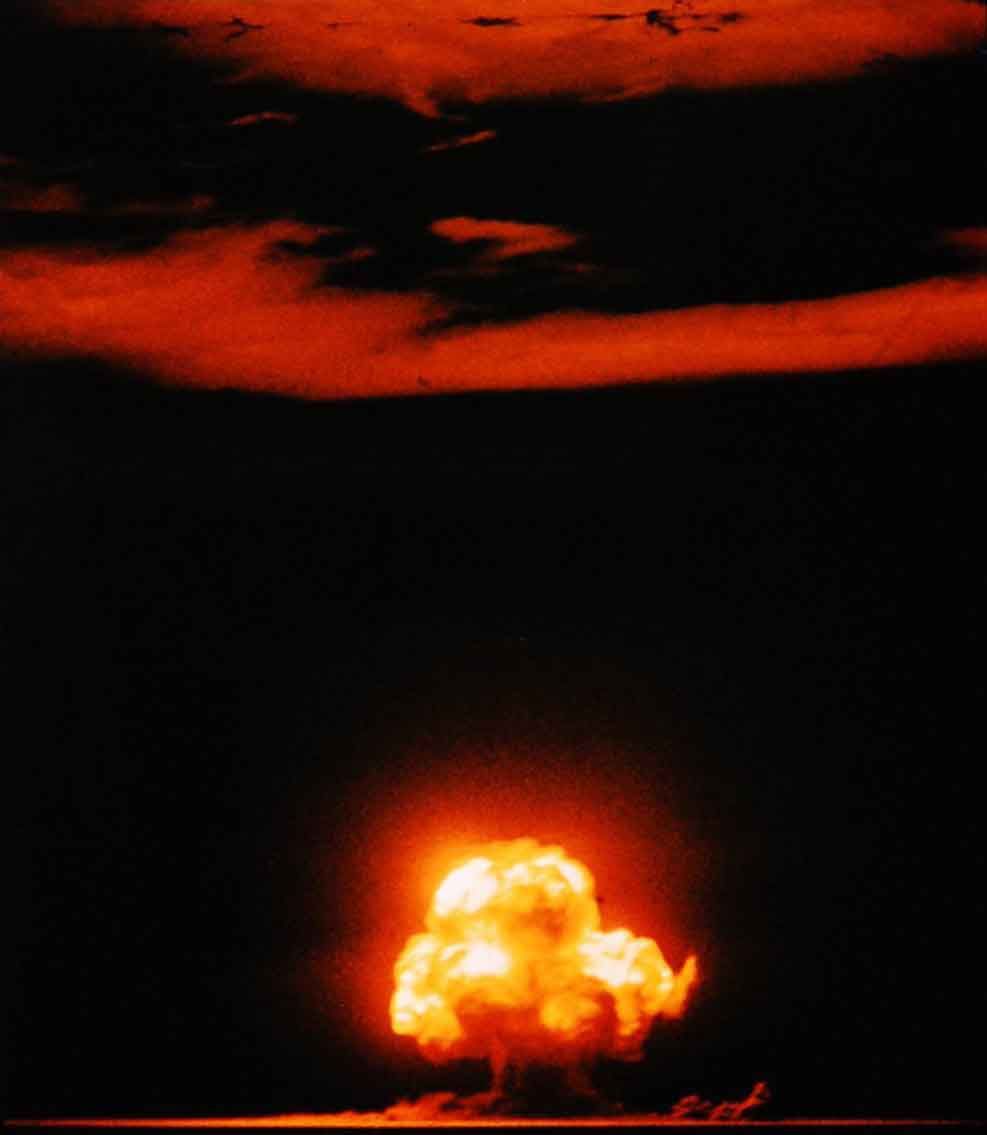
Count down
Early in July, Oppenheimer had told me of the approaching meeting beginning July 15, of Truman, Churchill and Stalin. A successful test was a card which Truman had to have in his hand.
The schedule for the test was such that as soon as the plutonium for the bomb was ready, everything else should be ready and the test would be held. There was a little delay but not much. Instructions from Washington were that no day was to be lost and it wasn’t. The nuclear assembly and final explosives were completed at Alamogordo and the shot was scheduled for July 16. (R. F. Bacher, “Robert Oppenheimer,” Proceedings of the American Philosophical Society. 116 (1972), 219)
E.M. Purcell and Victor Weisskopf showed theoretically that the SCR-584 radar would probably have only a range of a mile or two, insufficient to follow the rise of the ball of fire expected after the detonation. A trial would be made anyhow, and the radar before the detonation still retained its important function of providing wind velocities at all levels as it followed balloons carrying small corner reflectors.
We were fortunate to secure Captain Marvin Allen who arranged for some Army searchlights to follow by simple triangulation the ball of fire and mushroom cloud by night, or by day with an attached optical finder. No electrical pick-up troubles would be incurred as the searchlights were located miles away from Point Zero and the test area wiring. Precise location of the searchlights and radars was a necessity. With some further exploration, I found bench marks at several locations proving that not all the mapping of New Mexico had been done in the backrooms of frontier saloons, as frequently appeared to be the case.
The ranch roads which Frank Oppenheimer and I had located, and mapped on orders from General Groves for use as escape routes from the Base Camp, were considered by the General impassible in spots and were scraped for some miles. Frank and I were used to day or night driving in the desert and anything not traversed by arroyos had seemed serviceable to us.
Herb Anderson’s experiment required that one way or another samples of the earth in the crater would be collected as soon as possible after the bomb explosion. One hope had been to use a semirigid dirigible, or a blimp, to lower a grab bucket to pick up samples as a backup for the rockets. Unfortunately those available would not behave very well at the high altitude and desert temperature conditions with their bases so far away. The few helicopters available at that time didn’t have enough operating leeway to do much beyond support the pilot. We also had in mind a blimp or helicopter as a rescue vehicle if we used a shielded tank to recover samples of sand. If the tank should get stuck in highly radioactive sand, it would be well to get the driver and scientist-passenger out of there in a hurry. As the aerial rescue methods were canceled out, preparations were made to shield two tanks with lead, one for the reconnaissance and one held in reserve as a rescue vehicle. Unfortunately on July 16, only one tank was operative.
Activities had quieted down somewhat on the 15th. One or two weeks of rehearsals and timing trials were coming to a close except for a few groups who had more difficult measurements to perform. The bomb was now on the tower and the Base Camp was bulging so that many people who had worked hard at Los Alamos and had every right to witness the test were required to go to a location at Compagna Hills about 20 miles away from Point Zero. David Dow was in charge of that site and had a shortwave radio to hear the final countdown at the frequency for ground-to-B-29 communication from S 10,000. The frequency was meant to be different from that of any licensed station. Unfortunately, Security had allotted us the Voice of America’s frequency. Our FM radios, which several guard stations, the Base Camp and many jeeps and cars were equipped with for local communication, had been assigned the frequency of the railroad freight yard in San Antonio, Texas. Though far away, we could hear them shifting freight cars by number and presumed that they could hear us. The Socorro Airport listened in too.
Sunday supper, July 15, ended in a general meeting at which a colonel on General Groves’ staff gave suggestions on how to avoid eye damage, being knocked down by the blast, and how to evacuate the Base if fall-out came that way.
I had been in the test area nearly all day. Back at the Base I was furious to hear of discussions of the possibility that the atmosphere might be detonated. This possibility had been discussed at Los Alamos and had been quashed by intensive studies of all possibilities by Hans Bethe and others. It was thoughtless bravado to bring up the subject as a table and barracks topic before soldiers unacquainted with nuclear physics and with the results of Bethe’s studies.
The idea of runaway nuclear energy was not new. In 1903 Rutherford had quipped, “Some fool in a laboratory might blow up the universe unawares.” A. S. Eddington in 1920 first suggested that the source of the Sun’s energy might be the conversion of hydrogen to helium. Commenting on this in 1922, Aston wrote on the general problem of nuclear energy, and on fusion particularly:
Should the research worker of the future discover some means of releasing this energy in a form which could be employed, the human race will have at its command powers beyond the dreams of scientific fiction; but the remote possibility must always be considered that the energy once liberated will be completely uncontrollable and by its intense violence detonate all neighbouring substances. In this event the whole of the hydrogen on the earth might be transformed at once and the success of the experiment published at large to the universe as a new star. F.W. Aston, Isotopes (London: Edward Arnold and Co., 1922).)
“Neighboring substances” certainly included the atmosphere. We all put our faith in Bethe.
My personal nightmare was knowing that if the bomb didn’t go off or hangfired, I, as head of the test, would have to go to the tower first and seek to find out what had gone wrong. I had had a minor taste of this sort of thing. At Los Alamos I participated in a test on a full-scale implosion bomb with an inert core. The idea of that test was to shoot 20-mm cannon shells into the explosive-containing casing as a test of what Japanese fighter pilots might do to a real bomb over Japan. Shots were fired and the explosive lens assembly did not blow up.
Roger Warner, who was one of those with me at the time, and I waited for what I thought was a long enough time. We then walked out of our protective barricade to inspect the damage, but soon after we left smoke started to curl out of the holes in the casing. This induced a rapid retreat to shelter. Nothing more happened for a long time so we withdrew to let the bomb sit for a few hours. Later we did inspect it, and blew it up to get rid of it. Apparently, a direct hit on a detonator might be necessary to make the bomb blow up, but a fire could do equally well in the case of a confined explosive. The smoke we had seen earlier indicated that by good luck only a small amount of explosive had burned.
Arming party
The first possible time for the detonation of the real bomb had been set for 2 a.m. July 16, and the Arming Party was scheduled to arrive at Point Zero-the tower supporting the bomb—before 11 p.m. July 15. At that hour, Don Hornig would connect the cables to the bomb and detach the detonating unit used in rehearsals. Inasmuch as Louis Hempelmann, Paul Aebersold and I were the “Entry Permission Group,” which was formed to decide who might enter the test area to recover records after a survey had been made of levels of radioactivity following the blast, I had no idea when I could finally return to barracks on the 16th. So about 8 p.m. on the 15th, all duties having been fulfilled to that time except the ultimate one of arming the bomb, I asked the M.P. Sergeant on duty to wake me up at 10 p.m. and went to my barracks to get some sleep. The weather prognosis was poor.
When the time came to go to Point Zero, I drove Joe McKibben and Kistiakowsky in my car; I had selected them to be in the Arming Party. Jack Hubbard, Sergeants W. Stewart and J. C. Alderson—the weather group—went in a truck or car with their equipment. Bush and Sgt. Lloyd took a third vehicle; they were there, I believe under General Groves’ orders, to prevent possible last-minute sabotage attempts and give assistance if needed.
On the way in, I stopped at S 10,000 and locked the main sequence timing switches. Pocketing the key I returned to the car and continued to Point Zero. Soon after our arrival, Hornig completed his work and returned to S 10,000. Hornig was the last man to leave the top of the tower.
The weather men got to work with their instruments and balloons to get the wind speed and direction, humidity and temperature at all levels to 20,000 feet above our ground location (5,000 feet above sea level).
Sporadic rain was a disturbing factor. Every once in a while Bush or Lloyd would flick a flashlight around the tower, or one of us would leave the car to see that no activity was going on except the work of the weather group. Kisty went to the first landing on the tower to re-adjust a light as an aiming point reference for the cameras at W 10,000. Jack Hubbard gave progressive forecasts well ahead of the possible time for detonation. At midnight our earliest possible 2 a.m. shot had to be canceled. Soon everyone was told to get out of the test area as we might shoot at 4 a.m. Then zero time set for 4 a.m. was washed out. A telephone on one leg of the tower was linked to Williams at S 10,000. When it got too wet at the telephone, I would return to the car near the tower in which Bush, Lloyd, Kisty, and McKibben were located. If Williams had something to report, he called me by radio and I could return to the telephone. Security.
We had none of the lightning reported by those at the Base Camp about 16,000 yard away or at S 10,000, but it made interesting conversation as many of the wires from N,S,W 10,000 ended at the tower. Williams insulated me from whatever the tensions were at S 10,000. Finally, just before 4:45 a.m., Hubbard gave me a complete weather report and a prediction that at 5:30 a.m. the weather at Point Zero would be possible but not ideal. We would have preferred no inversion layer at 17,000 feet but not at the expense of waiting over half a day. I called Oppenheimer and General Farrell to get their agreement that 5:30 a.m. would be T = 0.
Then Williams came to the phone. We had arranged that I would report each step taken in the arming process so that if anything went wrong, he would know what had been at fault. I drove McKibben to W 900 so that he could throw the timing and sequence switches there while I checked off his list. Returning to the base of the tower, I reported to Williams again and threw the special arming switch which was not on McKibben’s lines. Until this switch was closed the bomb could not be detonated from S 10,000. The final task was to switch on a string of lights on the ground which were to serve as an “aiming point” for a B-29 practice bombing run. The Air Force wanted to know what the blast effects would be like on a plane 30,000 feet up and some miles away, simulating a bomb drop and scramble from the target area. The plane, dodging thunderheads, was not in proper position, but was 15 or 20 miles away when the bomb went off.
After turning on the lights, I returned to my car and drove to S 10,000, arriving about 5:00 a.m. The next step was to broadcast the wind velocity and elevation data to Compagna Hills, N and W 10,000. With the weather the way it was, only the higher elevation data was good at points other than Point Zero.
I unlocked the master switches and McKibben started the timing sequence at -20 minutes, 5:09: 45 a.m. At -45 seconds a more precise automatic timer took over. At the final seconds another circuit, designed by Titterton, sent out electronically timed signals for the still more precise pulses needed by many special instruments.
At -30 seconds I left the S 10,000 shelter and found Bill Elmore 20 yards away, who let me use a section of his sheet of foam rubber to lie down on. We all had welder’s goggles and I looked in the direction of Little Burro Peak which was to the right and behind me.
The bomb detonated at T = 0 = 5:29:45 a.m. I felt the heat on the back of my neck, disturbingly warm. Much more light was emitted by the bomb than predicted, the only important prediction which was off by a good factor. When the reflected flare died down, I looked at Oscuro Peak which was nearer Zero. When the reflected light diminished there I looked directly at the ball of fire through the goggles. Finally I could remove the goggles and watch the ball of fire rise rapidly. It was surrounded by a huge cloud of transparent purplish air produced in part by the radiations from the bomb and its fission products. No one who saw it could forget it, a foul and awesome display.
I had a feeling of exhilaration that the “gadget” had gone off properly followed by one of deep relief. I wouldn’t have to go to the tower to see what had gone wrong. I wouldn’t worry any longer: Had everything been properly anticipated? Was there one lousy soldered joint which had separated for some reason? Had some important circuit grounded because of the rain? Had someone in the final hours of activity, handicapped by fatigue, gotten careless and made the wrong connection or substituted a dummy unit used in rehearsals for the proper final unit?
After the blast wave had passed, I got up from the ground to congratulate Oppenheimer and others on the success of the implosion method. I finished by saying to Robert, “Now we are all sons of bitches.” Years later he recalled my words and wrote me, “We do not have to explain them to anyone.” I think that I will always respect his statement, although there have been some imaginative people who somehow can’t or won’t put the statement in context and get the whole interpretation. Oppenheimer told my younger daughter in 1966 that it was the best thing anyone said after the test.
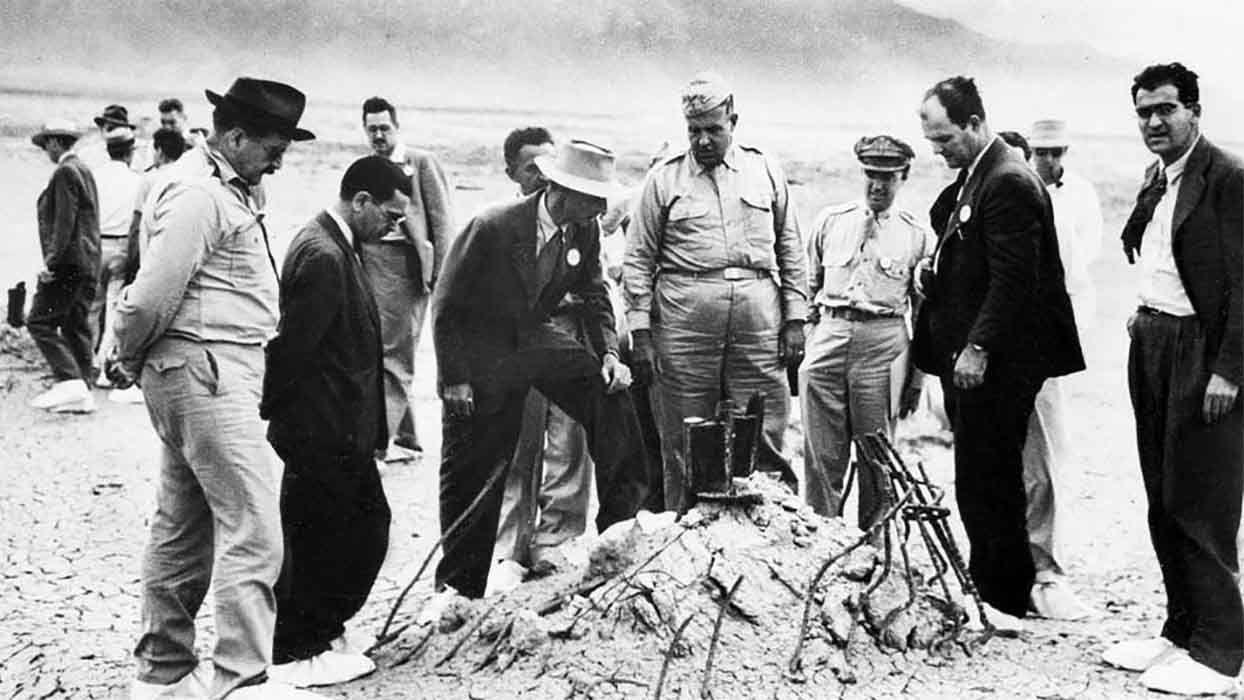
Within an hour only a small group remained at S 10,000. The rest had returned to the Base Camp three miles away.
After the ball of fire had gone into the 30,000 to 35,000 foot region, it was apparent with increasing daylight that some radioactivity had been trapped below the 17 ,000-foot above-ground inversion layer which Jack Hubbard had observed by his weather balloon measurements. We also knew that when the Sun rose, cool air came down into the valley. I remember some rapid calculations of the hazards assuming that a small percentage of the fission products would be caught in a volume of air 3 miles high, 6 miles wide, and 12 miles long. Two or three hours after the explosion, when the Sun heated the central valley air. Hempelmann’s counters began to click more and more rapidly at S 10,000. We put on dust masks as the counting rate increased. Finally the radioactivity decreased as the air was slowly swept away.
J.G. Hoffman or Aebersold made surveys of the roads to Base and the Compagna Hills and one of them went with me on the two roads leading from W 10,000 and S 10,000 to Point Zero. When the radioactivity on the ground approached a dangerous level we turned around and came back to S 10,000. It was apparent that few of the records buried in protective bunkers could be recovered that day. Also the success of the test and some immediately available test results meant that there was no great hurry anyway. The only entry to the vicinity of the crater would be made by Sgt. Bill Smith and Herb Anderson in the shielded tank, so Hempelmann and I didn’t have much more to do after the tank returned safely from the hazardous trip.
I got into my car at about 3 p.m., straying off the road once, and returned to my bunk to sleep it off. I did chance to see E. 0. Lawrence who, after congratulations, gave me a present of a bottle of precious bourbon which was hoarded until I could appreciate it
Together, we make the world safer.
The Bulletin elevates expert voices above the noise. But as an independent nonprofit organization, our operations depend on the support of readers like you. Help us continue to deliver quality journalism that holds leaders accountable. Your support of our work at any level is important. In return, we promise our coverage will be understandable, influential, vigilant, solution-oriented, and fair-minded. Together we can make a difference.
Keywords: Harry Truman, Hiroshima, J. Robert Oppenheimer, Los Alamos, Trinity, archive75, atomic bomb, radiation
Topics: Nuclear Risk
